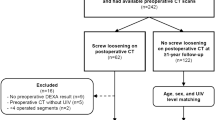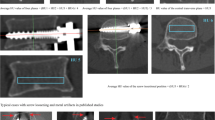Abstract
Introduction
Pedicle screw fixation is the standard technique for the stabilization of the spine, a clinically relevant complication of which is screw loosening. This retrospective study investigates whether preoperative CT scanning can offer a predictor of screw loosening.
Methods
CT-scan attenuation in 365 patients was evaluated to determine the mean bone density of each vertebral body. Screw loosening or dislocation was determined in CT scans postoperatively using the standard radiological criteria.
Results
Forty-five of 365 patients (12.3 %; 24 male, 21 female) suffered postoperative screw loosening (62 of 2038 screws) over a mean follow-up time of 50.8 months. Revision surgeries were necessary in 23 patients (6.3 %). The correlation between decreasing mean CT attenuation in Hounsfield Units (HU) and increasing patient age was significant (p < 0.001). Mean bone density was 116.3 (SD 53.5) HU in cases with screw loosening and 132.7 (SD 41.3) HU in cases in which screws remained fixed. The difference was statistically significant (p = 0.003).
Conclusion
The determination of bone density with preoperative CT scanning can predict the risk of screw loosening and inform the decision to use cement augmentation to reduce the incidence of screw loosening.


Similar content being viewed by others
References
Boos N, Webb JK (1997) Pedicle screw fixation in spinal disorders: a European view. Eur Spine J 6:2–18
Burval DJ, McLain RF, Milks R, Inceoglu S (2007) Primary pedicle screw augmentation in osteoporotic lumbar vertebrae: biomechanical analysis of pedicle fixation strength. Spine (Phila Pa 1976) 32:1077–1083. doi:10.1097/01.brs.0000261566.38422.40
Cho W, Cho SK, Wu C (2010) The biomechanics of pedicle screw-based instrumentation. J Bone Joint Surg Br 92:1061–1065. doi:10.1302/0301-620X.92B8.24237
Coe JD, Arlet V, Donaldson W, Berven S, Hanson DS, Mudiyam R, Perra JH, Shaffrey CI (2006) Complications in spinal fusion for adolescent idiopathic scoliosis in the new millennium. A report of the Scoliosis Research Society Morbidity and Mortality Committee. Spine (Phila Pa 1976) 31:345–349. doi:10.1097/01.brs.0000197188.76369.13
Coe JD, Warden KE, Herzig MA, McAfee PC (1990) Influence of bone mineral density on the fixation of thoracolumbar implants. A comparative study of transpedicular screws, laminar hooks, and spinous process wires. Spine (Phila Pa 1976) 15:902–907
Defino HL, Vendrame JR (2001) Role of cortical and cancellous bone of the vertebral pedicle in implant fixation. Eur Spine J 10:325–333
Galbusera F, Volkheimer D, Reitmaier S, Berger-Roscher N, Kienle A, Wilke HJ (2015) Pedicle screw loosening: a clinically relevant complication? Eur Spine J 24:1005–1016. doi:10.1007/s00586-015-3768-6
Halvorson TL, Kelley LA, Thomas KA, Whitecloud TS, 3rd, Cook SD (1994) Effects of bone mineral density on pedicle screw fixation. Spine (Phila Pa 1976) 19:2415–2420
Kocak T, Cakir B, Reichel H, Mattes T (2010) Screw loosening after posterior dynamic stabilization–review of the literature. Acta chirurgiae orthopaedicae et traumatologiae Cechoslovaca 77:134–139
Lee S, Chung CK, Oh SH, Park SB (2013) Correlation between Bone mineral density measured by dual-energy X-Ray absorptiometry and Hounsfield units measured by diagnostic CT in Lumbar Spine. J Kor Neurosurg Soc 54:384–389. doi:10.3340/jkns.2013.54.5.384
Lehman RA, Jr., Kuklo TR (2003) Use of the anatomic trajectory for thoracic pedicle screw salvage after failure/violation using the straight-forward technique: a biomechanical analysis. Spine (Phila Pa 1976) 28:2072–2077. doi:10.1097/01.BRS.0000084628.37133.BA
McAfee PC, Weiland DJ, Carlow JJ (1991) Survivorship analysis of pedicle spinal instrumentation. Spine (Phila Pa 1976) 16:S422–S427
Mohi Eldin MM, Ali AM (2014) Lumbar transpedicular implant failure: a clinical and surgical challenge and its radiological assessment. Asian Spine J 8:281–297. doi:10.4184/asj.2014.8.3.281
Orphanoudakis SC, Jensen PS, Rauschkolb EN, Lang R, Rasmussen H (1979) Bone mineral analysis using single-energy computed tomography. Invest Radiol 14:122–130
Pickhardt PJ, Pooler BD, Lauder T, del Rio AM, Bruce RJ, Binkley N (2013) Opportunistic screening for osteoporosis using abdominal computed tomography scans obtained for other indications. Ann Intern Med 158:588–595. doi:10.7326/0003-4819-158-8-201304160-00003
Rollinghoff M, Schluter-Brust K, Groos D, Sobottke R, Michael JW, Eysel P, Delank KS (2010) Mid-range outcomes in 64 consecutive cases of multilevel fusion for degenerative diseases of the lumbar spine. Orthopedic reviews 2:e3. doi:10.4081/or.2010.e3
Schreiber JJ, Anderson PA, Rosas HG, Buchholz AL, Au AG (2011) Hounsfield units for assessing bone mineral density and strength: a tool for osteoporosis management. J Bone Joint Surg Am 93:1057–1063. doi:10.2106/JBJS.J.00160
Schwaiger BJ, Gersing AS, Baum T, Noel PB, Zimmer C, Bauer JS (2014) Bone mineral density values derived from routine lumbar spine multidetector row CT predict osteoporotic vertebral fractures and screw loosening. AJNR Am J Neuroradiol 35:1628–1633. doi:10.3174/ajnr.A3893
Shea TM, Laun J, Gonzalez-Blohm SA, Doulgeris JJ, Lee WE 3rd, Aghayev K, Vrionis FD (2014) Designs and techniques that improve the pullout strength of pedicle screws in osteoporotic vertebrae: current status. Biomed Res Int 2014:748393. doi:10.1155/2014/748393
Tay WL, Chui CK, Ong SH, Ng AC (2012) Osteoporosis screening using areal bone mineral density estimation from diagnostic CT images. Acad Radiol 19:1273–1282. doi:10.1016/j.acra.2012.05.017
Wesarg S, Kirschner M, Becker M, Erdt M, Kafchitsas K, Khan MF (2012) Dual-energy CT-based assessment of the trabecular bone in vertebrae. Methods Inf Med 51:398–405. doi:10.3414/ME11-02-0034
Wu JC, Huang WC, Tsai HW, Ko CC, Wu CL, Tu TH, Cheng H (2011) Pedicle screw loosening in dynamic stabilization: incidence, risk, and outcome in 126 patients. Neurosurg Focus 31:E9. doi:10.3171/2011.7.FOCUS11125
Wu ZX, Gong FT, Liu L, Ma ZS, Zhang Y, Zhao X, Yang M, Lei W, Sang HX (2012) A comparative study on screw loosening in osteoporotic lumbar spine fusion between expandable and conventional pedicle screws. Arch Orthop Trauma Surg 132:471–476. doi:10.1007/s00402-011-1439-6
Wurgler-Hauri CC, Kalbarczyk A, Wiesli M, Landolt H, Fandino J (2008) Dynamic neutralization of the lumbar spine after microsurgical decompression in acquired lumbar spinal stenosis and segmental instability. Spine (Phila Pa 1976) 33:E66–E72. doi:10.1097/BRS.0b013e31816245c0
Zindrick MR, Wiltse LL, Widell EH, Thomas JC, Holland WR, Field BT, Spencer CW (1986) A biomechanical study of intrapeduncular screw fixation in the lumbosacral spine. Clin Orthop Relat Res 99–112
Acknowledgments
The investigation was supported by the work of Nadja Momotow und Lisa Hölscher.
Author information
Authors and Affiliations
Corresponding author
Ethics declarations
Conflict of interest
The authors declare that they have no conflicts of interest.
Rights and permissions
About this article
Cite this article
Bredow, J., Boese, C.K., Werner, C.M.L. et al. Predictive validity of preoperative CT scans and the risk of pedicle screw loosening in spinal surgery. Arch Orthop Trauma Surg 136, 1063–1067 (2016). https://doi.org/10.1007/s00402-016-2487-8
Received:
Published:
Issue Date:
DOI: https://doi.org/10.1007/s00402-016-2487-8




